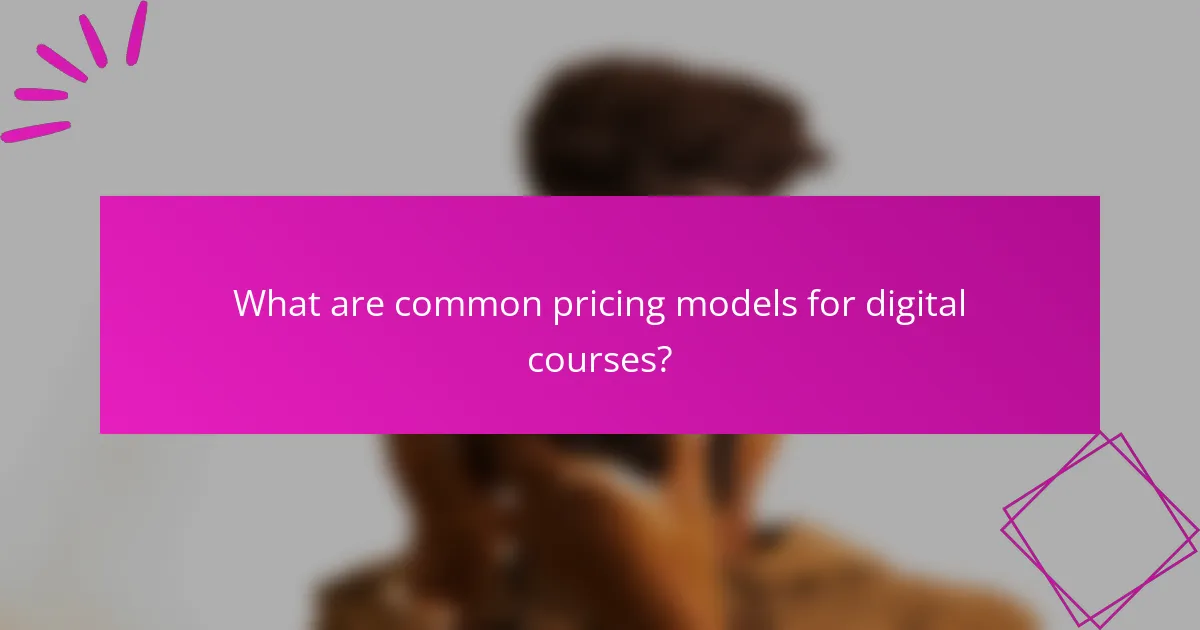Determining the right price for your digital course is crucial for attracting students and maximizing revenue. Key factors such as market competition, audience willingness to pay, and the perceived value of your content play significant roles in shaping your pricing strategy. By carefully considering these elements and exploring various pricing models, you can set a price that reflects the quality of your course while meeting the expectations of your target audience.

How to price digital courses in Canada?
To price digital courses in Canada effectively, consider factors like market competition, audience willingness to pay, and the value your course provides. A well-researched pricing strategy can enhance sales and ensure your course is perceived as valuable.
Market research on competitor pricing
Conducting market research on competitor pricing involves analyzing similar courses offered in Canada to understand their price points. Look for courses with comparable content, length, and delivery methods to gauge a competitive range, typically between CAD 50 to CAD 500.
Utilize online platforms and course marketplaces to gather data on pricing strategies. This can help you identify trends, such as whether competitors offer discounts or bundled packages, which can influence your pricing decisions.
Understanding target audience willingness to pay
Understanding your target audience’s willingness to pay is crucial for setting an appropriate price for your digital course. Conduct surveys or interviews to gather insights about their budget and perceived value of the course content.
Consider segmenting your audience based on demographics or professional backgrounds, as different groups may have varying price sensitivities. For instance, corporate professionals might be willing to pay more than students for the same content.
Value-based pricing strategies
Value-based pricing strategies focus on the perceived value of your course rather than just the cost of production. Highlight unique features, such as expert instructors or exclusive resources, that justify a higher price point.
To implement this strategy, clearly communicate the benefits and outcomes your course provides. For example, if your course offers a certification that enhances job prospects, this added value can warrant a higher price, potentially in the range of CAD 200 to CAD 800.

What factors influence digital course pricing?
Several key factors influence digital course pricing, including the quality of course content, the expertise of the instructor, and the delivery format. Understanding these elements can help you set a competitive and fair price for your course.
Course content quality and depth
The quality and depth of course content play a crucial role in determining its price. Courses that offer comprehensive, well-researched materials and practical applications tend to command higher prices. For instance, a course with in-depth modules, interactive elements, and real-world case studies can be priced in the higher range, often between $100 to $500.
Consider the learning outcomes and the value the content provides to students. If your course equips learners with in-demand skills or certifications, you can justify a premium price. Regularly updating content to reflect current trends can also enhance perceived value.
Instructor expertise and credentials
The instructor’s expertise and credentials significantly affect course pricing. Instructors with advanced degrees, industry experience, or recognized certifications can often charge more for their courses. A well-known expert in a specific field might price their course at a premium, potentially exceeding $1,000.
When setting prices, highlight your qualifications and any relevant achievements. If you have published work, received awards, or have a strong professional network, these factors can enhance your credibility and justify higher pricing.
Course delivery format and technology
The delivery format and technology used in a digital course can influence its price. Courses that offer live sessions, personalized feedback, or advanced interactive features typically cost more than self-paced, video-only options. For example, a live workshop might be priced at $300, while a pre-recorded course could range from $50 to $200.
Consider the costs associated with the technology you use, such as platform fees or software subscriptions. Ensure that the pricing reflects the value provided through the chosen delivery method, and be transparent about what students can expect from their learning experience.

What are common pricing models for digital courses?
Common pricing models for digital courses include one-time payments, subscription-based pricing, and tiered pricing structures. Each model has its own advantages and considerations that can impact both revenue and customer satisfaction.
One-time payment model
The one-time payment model requires learners to pay a single fee to access the course content. This approach is straightforward and often appealing to customers who prefer not to commit to ongoing payments.
When using this model, consider setting a price that reflects the course’s value and market demand. Prices typically range from $50 to several hundred dollars, depending on the course’s depth and complexity.
A common pitfall is undervaluing the course, which can lead to lower sales. Ensure the pricing aligns with the quality and outcomes promised to the learners.
Subscription-based pricing
Subscription-based pricing allows learners to pay a recurring fee, usually monthly or annually, for continued access to course materials and updates. This model can create a steady revenue stream and foster long-term customer relationships.
Pricing for subscriptions often ranges from $10 to $50 per month, depending on the content offered and the frequency of updates. Consider offering a free trial to attract new subscribers.
However, be cautious of overloading subscribers with content, which can lead to disengagement. Regularly assess subscriber feedback to ensure the value remains high.
Tiered pricing structures
Tiered pricing structures offer multiple pricing levels, each providing different access or benefits. This model allows customers to choose a plan that best fits their needs and budget.
For example, a basic tier might include access to standard course materials, while a premium tier could offer personalized coaching or additional resources. Prices can vary significantly, often from $30 for basic access to $200 or more for premium features.
When implementing tiered pricing, clearly communicate the differences between tiers to avoid confusion. Regularly review and adjust tiers based on customer feedback and market trends to optimize sales.

How to determine the right price point?
Determining the right price point for a digital course involves balancing perceived value with market demand. Consider factors such as target audience, content quality, and competitor pricing to establish a competitive yet profitable price.
Conducting A/B testing on pricing
A/B testing on pricing involves presenting different price points to segments of your audience to gauge their reactions. By comparing conversion rates, you can identify which price maximizes sales without sacrificing perceived value.
To implement A/B testing effectively, choose a clear timeframe and ensure that the audience segments are similar in characteristics. For example, you might test a price of $49 against $69 to see which generates more sales.
Analyzing customer feedback and sales data
Analyzing customer feedback and sales data is crucial for understanding how your pricing is perceived. Collect insights through surveys, reviews, and direct communication to gauge customer satisfaction and willingness to pay.
Review sales data to identify trends, such as which price points lead to higher conversion rates or customer retention. For instance, if a course priced at $99 consistently outperforms one at $149, it may indicate a price sensitivity in your target market.

What are the best practices for pricing digital courses?
Best practices for pricing digital courses involve regularly updating content, offering discounts, and creating bundled offerings. These strategies help maintain competitiveness and attract a wider audience while ensuring that the course remains valuable and relevant.
Regularly updating course content
Regularly updating course content is essential for keeping your digital course relevant and appealing. This practice not only enhances the learning experience but also justifies pricing adjustments over time. Consider revising your material at least once a year or whenever significant changes occur in your subject area.
When updating, focus on incorporating the latest industry trends, tools, or techniques. For example, if you offer a course on digital marketing, ensure that you include recent algorithm changes or emerging platforms. This keeps your course fresh and can help you maintain or even increase your pricing.
Offering discounts and promotions
Offering discounts and promotions can effectively attract new students and boost enrollment numbers. Common strategies include seasonal sales, early-bird pricing, or discounts for referrals. These tactics can create urgency and encourage potential learners to enroll sooner rather than later.
Consider implementing a tiered discount system where students receive larger discounts for enrolling in multiple courses or for signing up during specific promotional periods. For instance, a 20% discount for signing up within the first week of launch can incentivize quick decisions.
Creating bundled course offerings
Creating bundled course offerings allows you to provide more value to your customers while increasing your overall sales. By grouping related courses together, you can offer a discount compared to purchasing each course separately. This not only enhances the perceived value but also encourages students to explore more of your content.
For example, if you offer courses on web development, consider bundling beginner, intermediate, and advanced courses at a reduced rate. This approach can lead to higher customer satisfaction and retention, as students are more likely to continue learning when they have access to a comprehensive learning path.

How to communicate pricing effectively to potential buyers?
Communicating pricing effectively involves clearly articulating the value your digital course offers while being transparent about costs. Potential buyers appreciate straightforward information that helps them understand what they are paying for and why it is worth their investment.
Clear value proposition statements
A clear value proposition statement succinctly conveys the unique benefits of your digital course, helping potential buyers see its worth. Focus on what sets your course apart, such as specific skills taught, outcomes achieved, or exclusive resources provided.
For example, instead of simply stating “This course teaches coding,” you might say, “Master Python programming in 30 days with hands-on projects and personalized feedback.” This emphasizes the course’s effectiveness and the supportive learning environment.
When crafting these statements, ensure they resonate with your target audience’s needs and pain points. Use language that speaks directly to their aspirations, making it easier for them to justify the price based on the value they will receive.



